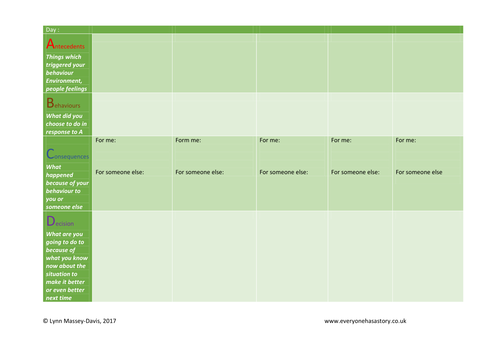

This is a modified version of the ABC model which is used in a wide range of school and clinical settings to modify undesirable behaviour. It is used by staff to help them reflect on the environmental triggers for behaviour for individuals and whole groups or in targeted behaviour interventions for whole people
What is different about this:
The language encourages reflection on self and behaviours rather than blaming someone else. The emphasis on the language is “you” and your behaviour and the choices made. This is very important because bad stuff happens to everyone and those people who mindfully respond to situations generally get a better outcome for themselves and others. Those who externalise their problems “so and so upset me” rarely change their behaviour because they have a ready-made excuse. The drip drip drip of focus on “your choice” “your behaviour” is the only means I know of helping them realise they may not have control over what happens to them but they can control how they respond.
The other main difference is that there isn’t just ABC – antecedents, behaviour, consequences but also D. Decision. When things have gone wrong in a situation it is tempting for everyone to do an autopsy. This isn’t helpful. The events are already “gone” and one the slab (to continue the metaphor). D is the “what next” “do something different” it could be setting a personal target. Or if things have gone well, encourage reflection on what well and making it “even better”. If this is about trying something different then try to change one behaviour at a time. So this takes the analysis from the past into trying to make future actions better or even better next time.
What is different about this:
The language encourages reflection on self and behaviours rather than blaming someone else. The emphasis on the language is “you” and your behaviour and the choices made. This is very important because bad stuff happens to everyone and those people who mindfully respond to situations generally get a better outcome for themselves and others. Those who externalise their problems “so and so upset me” rarely change their behaviour because they have a ready-made excuse. The drip drip drip of focus on “your choice” “your behaviour” is the only means I know of helping them realise they may not have control over what happens to them but they can control how they respond.
The other main difference is that there isn’t just ABC – antecedents, behaviour, consequences but also D. Decision. When things have gone wrong in a situation it is tempting for everyone to do an autopsy. This isn’t helpful. The events are already “gone” and one the slab (to continue the metaphor). D is the “what next” “do something different” it could be setting a personal target. Or if things have gone well, encourage reflection on what well and making it “even better”. If this is about trying something different then try to change one behaviour at a time. So this takes the analysis from the past into trying to make future actions better or even better next time.
Something went wrong, please try again later.
This resource hasn't been reviewed yet
To ensure quality for our reviews, only customers who have purchased this resource can review it
Report this resourceto let us know if it violates our terms and conditions.
Our customer service team will review your report and will be in touch.
£2.00